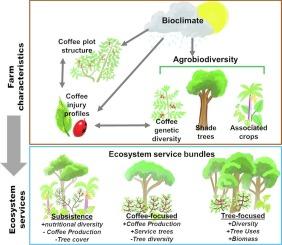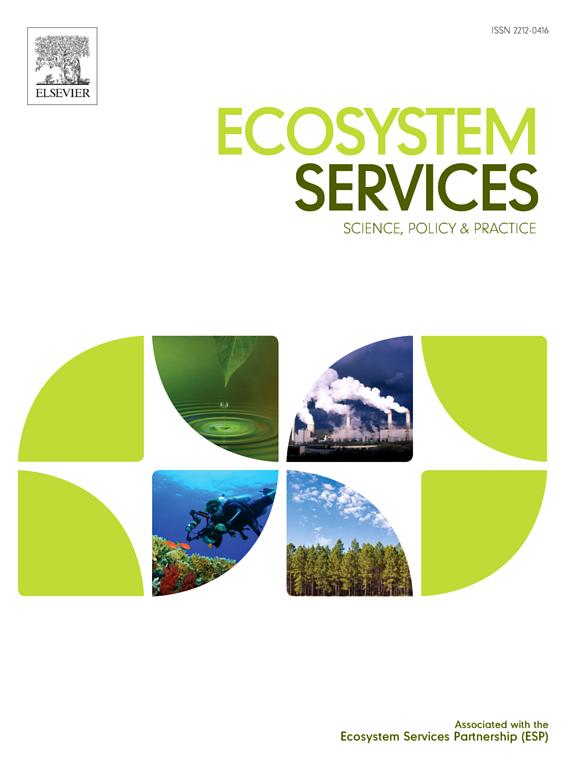Ecosystem service bundles associated with agrobiodiversity in agroforestry systems: A case study of two coffee-growing regions of Haiti
IF 6.6
2区 环境科学与生态学
Q1 ECOLOGY
引用次数: 0
Abstract
Smallholder Coffee agroforestry systems (CAFS) deliver ecosystem services bundles crucial to farmer livelihoods, resilience of rural communities, maintenance of natural processes, and biodiversity conservation. Their importance is likely greatest in countries with vulnerable populations such as Haiti. Nevertheless, little is known about service delivery by Haitian CAFS. Therefore, we characterized the agrobiodiversity of 39 representative CAFS in two coffee-growing regions of Haiti (North and Southwest), and the multiple services they support. We investigated associations between the composition and structure of agrobiodiversity and service delivery. To that end, CAFS typologies were established from variables pertaining to coffee genetic diversity, stand structure and injury profiles, shade tree and associated crop diversity, and bioclimate. Associations between typologies were investigated. We also established a typology based on delivered services related to coffee performance, species and nutritional diversity, tree uses, carbon storage, and nitrogen availability. Surveyed coffee plots were generally varietally diverse, aging, and subject to pest and diseases. Most CAFS occurred on a spectrum of farm regeneration (old to renewed coffee plots) tied to the adoption of “modern” coffee varieties, with implications for ecosystem service delivery. Furthermore, we described 3 distinct ecosystem service bundles delivered by CAFS: subsistence-, coffee performance-, and tree utility-maximizing bundles, respectively. Finally, our results highlight the importance of the tree strata for ES, including conservation of native species. Overall, our study contributes to the still-limited knowledge of Haitian CAFS agrobiodiversity. Trade-offs between certain services, and absence of trade-offs between others, signal possible CAFS improvement pathways.

农林复合系统中与农业生物多样性相关的生态系统服务束:海地两个咖啡种植区的案例研究
小农咖啡农林复合系统(CAFS)提供的生态系统服务对农民生计、农村社区抵御力、维持自然过程和保护生物多样性至关重要。在海地等人口脆弱的国家,它们的重要性可能最为突出。然而,人们对海地中非援助部队提供的服务知之甚少。因此,我们对海地两个咖啡种植区(北部和西南部)39个代表性CAFS的农业生物多样性及其支持的多种服务进行了表征。我们调查了农业生物多样性的组成和结构与服务提供之间的关系。为此,从咖啡遗传多样性、林分结构和伤害概况、遮荫树和相关作物多样性以及生物气候等变量建立了CAFS类型。研究了类型学之间的关联。我们还根据与咖啡性能、物种和营养多样性、树木利用、碳储存和氮可用性相关的交付服务建立了类型学。调查的咖啡地块一般品种多样,老化,易患病虫害。大多数CAFS发生在与采用“现代”咖啡品种有关的农场再生(旧咖啡到新咖啡地块)的范围内,这对生态系统服务的提供具有影响。此外,我们还描述了CAFS提供的3种不同的生态系统服务束:生存最大化、咖啡性能最大化和树木效用最大化。最后,我们的研究结果强调了树木层对ES的重要性,包括对本地物种的保护。总的来说,我们的研究对海地CAFS农业生物多样性的认识仍然有限。某些服务之间的权衡,以及其他服务之间缺乏权衡,表明了可能的CAFS改进途径。
本文章由计算机程序翻译,如有差异,请以英文原文为准。
求助全文
约1分钟内获得全文
求助全文
来源期刊

Ecosystem Services
ECOLOGYENVIRONMENTAL SCIENCES&-ENVIRONMENTAL SCIENCES
CiteScore
14.90
自引率
7.90%
发文量
109
期刊介绍:
Ecosystem Services is an international, interdisciplinary journal that is associated with the Ecosystem Services Partnership (ESP). The journal is dedicated to exploring the science, policy, and practice related to ecosystem services, which are the various ways in which ecosystems contribute to human well-being, both directly and indirectly.
Ecosystem Services contributes to the broader goal of ensuring that the benefits of ecosystems are recognized, valued, and sustainably managed for the well-being of current and future generations. The journal serves as a platform for scholars, practitioners, policymakers, and other stakeholders to share their findings and insights, fostering collaboration and innovation in the field of ecosystem services.
 求助内容:
求助内容: 应助结果提醒方式:
应助结果提醒方式:


